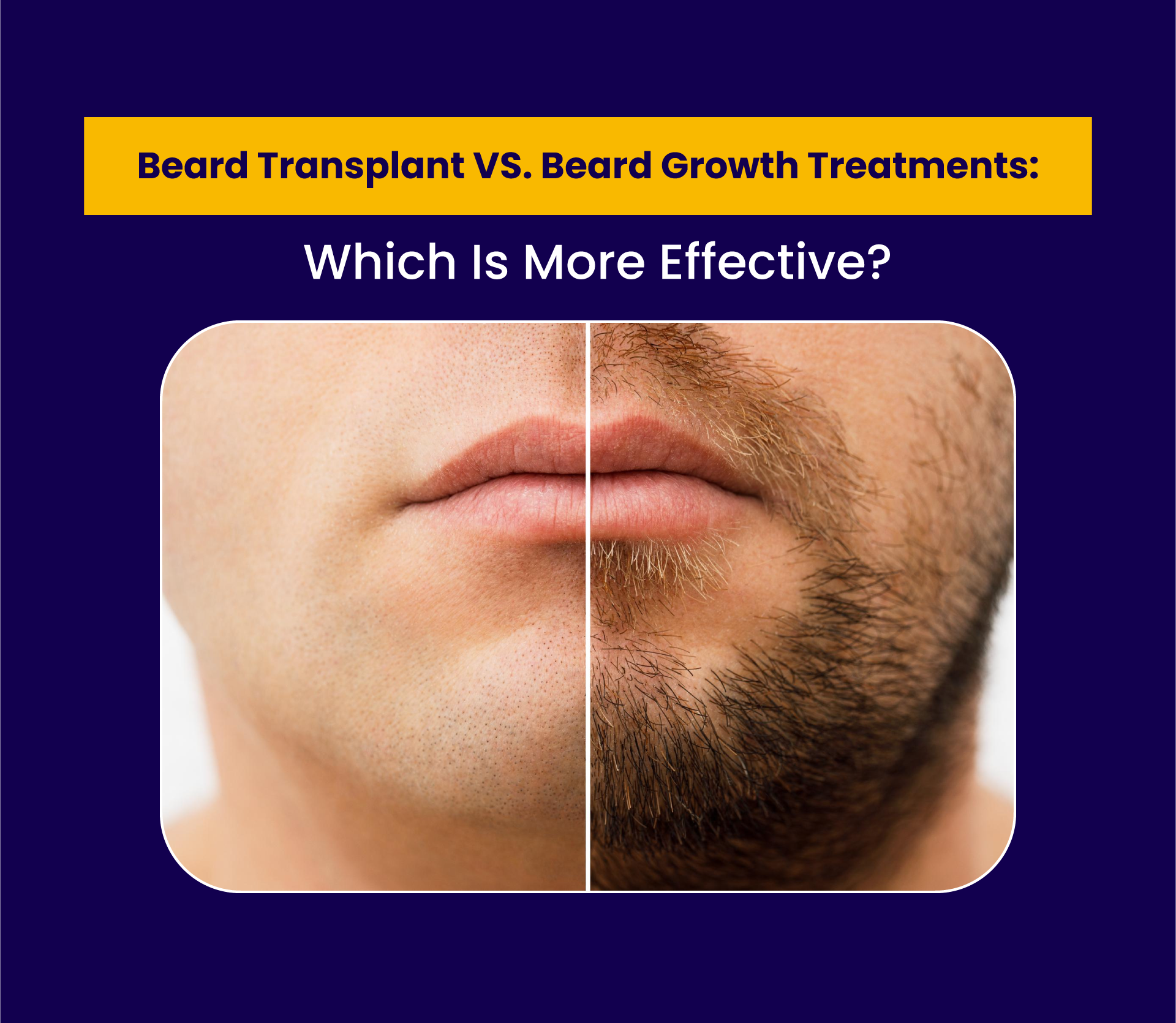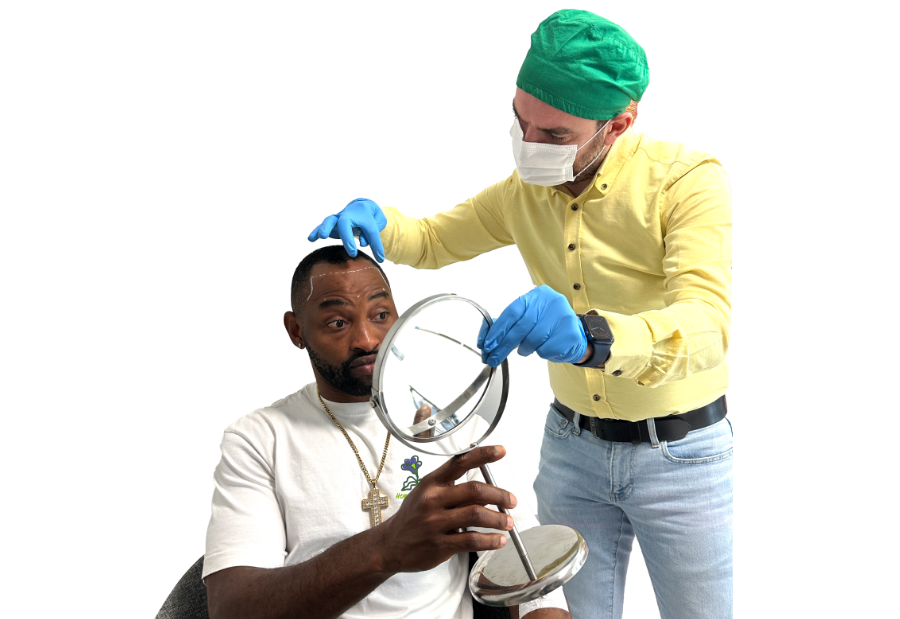Get 25% OFF Hair Transplant Packages This New Year — Book Today!
Beard Transplant vs. Beard Growth Treatments: Which Is More Effective?

Introduction
Beards are a style statement, a personality trait, and a confidence builder, but unfortunately, not everyone has the privilege of a full, even beard. Some men have patchy growth, while others have facial hair that is barely noticeable. This is where the search for answers begins. For the guys attempting to grow their sheepdog, it usually comes down to Beard Transplant vs. Beard Growth treatments: what really works better? Let’s break it down step by step to find the right route to that fuller, thicker beard.
Understanding Beard Growth Challenges
Common Causes of Patchy or Sparse Beard Growth
Not all beards grow the same. Some men are lucky enough to have fuller growth in only a few months, while others deal with patchy or wasted growth for years. The most common reasons for patchy growth can be attributed to genetics, hormones, stress, poor diet, and skin conditions. For many, no matter how long they wait or how many times they shave, their beard just does not grow the way they want it to.
Why People Seek Solutions for Beard Enhancement
Beards can transform how a person looks and feels. That’s why more people today are looking for ways to fill in the gaps. Some want to correct uneven growth, while others are looking to build a beard from scratch. Whether it’s for style, confidence, or professional appearance, men are turning to both non-surgical treatments and beard hair surgery to get the job done.
What Is a Beard Transplant?
How the Procedure Works
A beard transplant involves taking healthy hair follicles, usually from the back of your scalp, and implanting them into the beard area. This method is also called beard implants’ or ‘beard hair transplant surgery’. The process is similar to a scalp hair transplant, but the design focuses on shaping and filling the beard. This procedure is often done under local anesthesia and can take a few hours, depending on how much coverage is needed.
Pros and Cons of Beard Transplants
The biggest advantage of a beard hair transplant is that it gives permanent, natural-looking results. You can shape your beard as desired, and the new hairs grow just like natural facial hair. You can trim, shave, and style them without worry. However, beard hair surgery is not for everyone. The cost can be high, especially in some countries. Still, medical tourism for beard transplant Istanbul services has gained popularity because of affordability and experienced surgeons.
The downside includes a longer recovery period and the risk of minor scarring or infection. There’s also a waiting period before full results are visible.
Overview of Beard Growth Treatments
Topical Solutions (Minoxidil, etc.)
One of the most widely known treatments for boosting beard growth is minoxidil. This over-the-counter topical solution is applied directly to the skin. It works by stimulating blood flow to the follicles, potentially encouraging new growth. Many users report positive results, especially when used consistently for several months. However, the effects can stop if usage is discontinued.
Oral Supplements and Vitamins
Supplements like biotin, zinc, and vitamin D are often marketed for hair health. These can support overall growth and improve hair texture. While they won’t give you a beard overnight, they can make a difference when used alongside good diet and lifestyle habits.
Microneedling and Other Non-Surgical Methods
Microneedling involves rolling a device with tiny needles over the skin to boost collagen production and improve blood circulation. When paired with serums or minoxidil, it may enhance results. Other methods include laser therapy and dermal fillers in extreme cases, but these are less commonly used for beard purposes.
If you’re considering a beard to scalp hair transplant, here’s everything you need to know about the procedure and its effectiveness.
Comparing Effectiveness
Results: Longevity and Appearance
A beard hair transplant provides long-lasting, natural-looking results that blend in with your existing hair. These follicles are permanent, and once they take root, they grow for life. In contrast, non-surgical options can offer good results but require ongoing use and maintenance.
Timeframe for Visible Results
With beard hair transplants, visible changes begin within three to four months, but the full beard look can take up to a year. Minoxidil users may notice early fuzz in a few weeks, but full results often take six months or longer. Supplements and other treatments may take even longer and often vary in effectiveness from person to person.
Suitability for Different Types of Beard Loss
Beard hair transplants are ideal for those with severe patchiness, scars, or very little beard to begin with. Nonsurgical treatments work better for mild to moderate thinning and are ideal for those who prefer a less invasive approach.
Cost Comparison
Initial Investment and Maintenance Costs
So, how much is a beard hair transplant? The price can vary greatly depending on the location, clinic reputation, and complexity of the procedure. In places like the US or UK, it can range from $5,000 to $15,000. However, beard hair transplant Istanbul packages offer a more affordable option, often starting around $2,000.
Topical treatments and supplements are less expensive upfront but can add up over time. Minoxidil might cost about $20 to $40 per month. Vitamins and microneedling tools come with their own costs and often need to be purchased repeatedly to maintain results.
Potential Risks and Side Effects
Complications with Transplants
While generally safe, beard surgery can lead to temporary swelling, redness, and discomfort. There is a minor risk of infection or graft failure if post-care is not followed correctly. Choosing a qualified surgeon greatly reduces these risks.
Side Effects of Growth Treatments
Minoxidil may cause dryness, flaking, or irritation on the skin. In rare cases, users experience rapid shedding before new hair appears. Supplements can also cause issues if overused, especially with high doses of biotin or other vitamins. It’s always wise to follow dosage instructions and consult a doctor when in doubt.
Which Option Is Right for You?
Factors to Consider: Age, Budget, Expectations
Choosing between Beard Transplant vs. Beard Growth options depends on your individual needs. If you’re young, still experiencing hormonal changes, or on a tight budget, trying growth treatments first makes sense. But if you’ve tried several methods with no success, a beard transplant may offer the solution you’re looking for.
Older candidates with stable beard patterns often benefit more from surgery. Budget also plays a big role. While surgery costs more upfront, it may prove more cost-effective in the long run compared to years of treatments.
Consulting a Specialist for Personalized Advice
Before making any decision, it’s important to consult a dermatologist or hair restoration expert. They can evaluate your skin, hair density, and beard goals to recommend the right path. A personalized plan increases your chances of success, whether you’re going for beard hair surgery or noninvasive solutions.
For more information on post-procedure care, visit our detailed guide on beard transplant recovery.
Conclusion: Making an Informed Choice for Your Beard
A full, healthy beard is achievable, but choosing how to get there requires careful thought. Beard hair transplants offer lasting, natural results but come with higher costs and longer recovery. Growth treatments are easier to try but demand patience and consistency. Whether you choose beard implants or topical solutions, the key is to match the method with your needs, goals, and lifestyle. With the right guidance and a bit of patience, your dream beard can become a reality.

